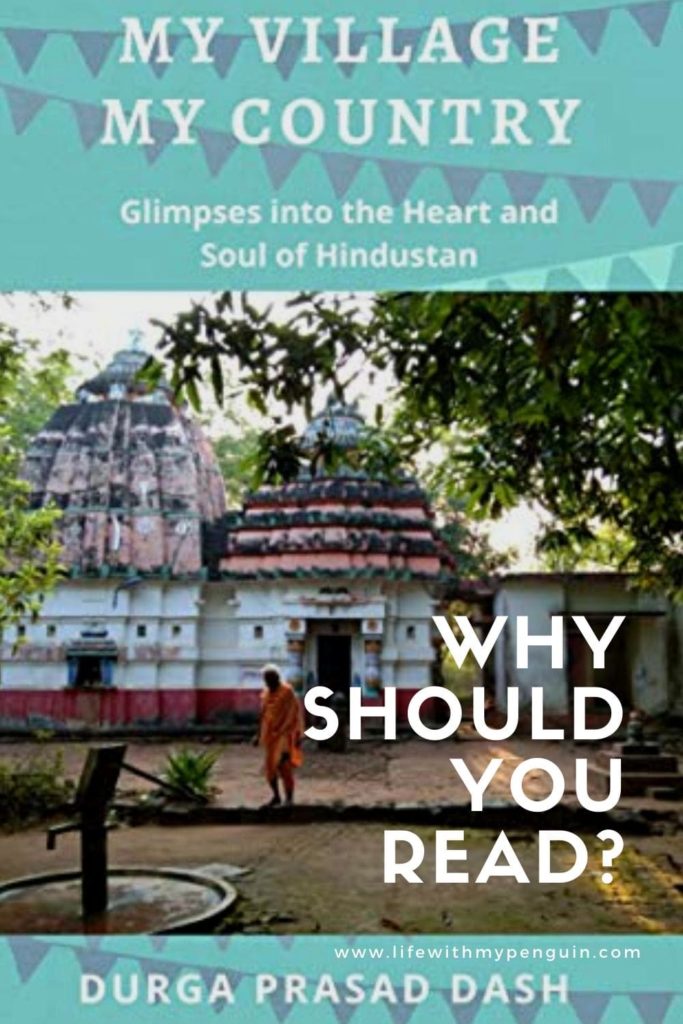Have you ever felt living abroad brought you closer to your homeland, your country? Or once you moved out of your hometown, the town and memories kept pulling you? This emotional bond, Place attachment is multidimensional. We carry a part of our native place, native culture, ingrained in our hearts and soul. Just we start carving for mom-made home-made food only after stepping out of the home. The taste lingers in our tongue even after a decade. A similar sense of attachment and connection was relived while reading the book, My Village My Country: Glimpses into the Heart and Soul of Hindustan by Durga Prasad Dash.
Book title: My Village My Country: Glimpses into the Heart and Soul of Hindustan
Author: Durga Prasad Dash
Genre: Indian History; Culture and philosophy
Get your copy: Kindle

Book Cover and title:
The book title would remind every reader of the popular Bollywood movie, Mera Goan Mera Desh. Precisely the author, Mr. Dash professes how the title falls handsomely capturing the essence of India in chapters.
Portraying India as a land of the emerging economy, industrial growth, holistic center hub, or by the division of races is not new. We often read books and articles about them. However, there is rural India too. The book title attracts readers to dive and explore the untouched beauty and surrealness of Indian villages, the soul of India.
The book cover synchronizes with the title. The real picture of an ancient Hindu temple with an old man presumably priest or devotee can charm readers who like the Indianness presented unaltered. Later the author discloses the temple being a thirteenth-century Shiva temple, Dakshineswara temple located near Nua Mahulia, the native village of the author. Surprisingly the temple was discovered, excavated, and renovated three decades ago.
This might remind bibliophiles about the loss and resurfacing treasures of Indian history, culture, architecture, arts, science, and more.
Why should you read this one? Not a book review
While I take great pleasure in talking about books and sharing my thoughts as reviews. This book turned out to be one that I wish more people get a chance to read. Why? Because it is hard to find one of kind that would take you to a depth of lost or losing heritage, yet talk about divinity.
The book spreads across 26 chapters titled in alphabetical fashion A to Z. Each chapter presents an aspect that binds with the theme of the book, Country, and Villages enriched with the author’s personal experiences. At times he would take you to his childhood memories around the village later he would offer a yogic point of view of sacred scriptures. The reading journey is hardly in linear regression.
The walks down the memory lanes are much more than reminiscences of tree climbing or train journeys, tactfully he would lead way to heritage.
If you ever had a chance to befriend Odias or fortunate enough of being one, you might know people of Odisha speak Odia and Odissi is a dance form. Few might immediately be reminded of the Puri Jagannath temple and Rath yatra. There would be few who link the state with the war that changed Ashoka. Unknown to many, Odisha is the land of exceptional arts, as covered right from the first chapter.
Read the book to discover –
- A festival celebration on the maritime achievements of presumable initial Merchants of East with Boita Bandana and Bali Jatra.
- The artistic relationship of Sun temple, Konark and Tagore.
- Thakurani jatra. Thakurani being the Divine Feminine. These jatras are renowned in local areas and each Thakurani goes by a local name.
- Deep dive into Danda jatra and understanding the form of Tapasya.
- Food that holds an essential role in history and culture including the disreputable debate of Rasagola and Rosogolla.
- Controversial nature of Indian history as portrayed with time and by power.
- The oral tradition of sharing spirituality with Pala nacha, Daskathia, natakas, etc.
Few might also enjoy the take on self-proclaimed spiritual erudite.
What I wished more?
While many readers pick book pulled by cover picture, this one might have needed little work on that front, from a marketing perspective.
The pictures in the book do touch the reader’s heart. Yet as a reader one might wish to see better clarity high definition pictures.
Division of chapters, this might work for some or not for others. Just as a reader is absorbing the unknown or less known rich legacy of Odisha, they get into the arguable nature of Indian history as documented, often misrepresented by foreigners, travelers and historians. An involved reader might like to know more about the state. Dividing chapters would be good for such readers.
At times, the screenshots of findings can be hard to read, a cleared picture would have been much appreciated.
Who should read the book?
Clearly with 26 chapters of My Village My Country showcasing the essence of rural India and spiritual discussions that leave you pondering is not meant for all. If books on the lesser-known history of India, culture, and philosophy excites you, then you won’t regret picking up this one. Ponder upon the stated facts, arguments, and redefine the connection with the soul of India.
About the author:
Durga Prasad Dash is a poet and author of 7 multi-genre books. He has been a soldier, yoga teacher, and trainer. You can find his writings on culture, philosophy, politics, and more on his blog. One can also reach him on twitter @dpdash67


Great review, Pragnya.
Shri Dash has shared lesser known facts.
Many are yet to know about Odisha. Such informative books can definitely help.
Agree with you, ma’am. The book has in-depth information about less known facts. Thank you for stopping by.
Thank you for this wonderful review.
It was a pleasure, Sir.